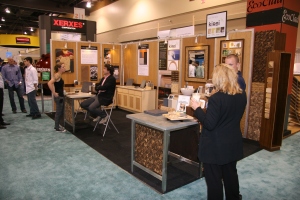
With a compact footprint, efficient envelope, and smart product decisions, The Sage soared past LEED-Platinum.
Play Slideshow >>
.

The modern kitchen features Pioneer Millworks reclaimed flooring, Energy Star-rated refrigerator and dishwasher from KitchenAid, locally sourced wood cabinets, and Squak Mountain recycled-content countertops. Clerestory windows flood the open room with natural light.
When Bill Randall and Arbor South Architecture set out to design their first LEED-certified project, they didn’t just limp in—they broke records. The Sage, a 1,447-square-foot, two-bedroom, two-bath home in Eugene, Ore., earned 110 LEED points, enough to qualify for Platinum status and earn the distinction of the highest-scoring LEED home west of the Rockies.
The house, completed last month and featured on the Eugene Home Builders Tour, is an educational tool for designer and consumer alike. For Arbor South, The Sage and its LEED certification process was an experience-building opportunity for a firm looking to redirect its design mission toward smaller, more efficient homes. With a modern aesthetic uncompromised by an extensive list of green features, the home also serves as an eye-opener for local buyers unaware that sustainable living and pleasing design go hand in hand.
“It’s designed and built in a way that shows how you can be off the charts in terms of efficiency, but still be aesthetically pleasing,” says Randall, AIA, LEED-AP. “It’s very aesthetically pleasing and very livable.”
Like most ultra-green homes, The Sage starts with a tight envelope, featuring double 2×4 stud walls, separate plates to eliminate thermal bridging, Demilec Agribalance spray-foam insulation for R-32 in the walls and R-45 in the vaulted ceilings, and tight sealing. As a result, the house is 12 times tighter than Energy Star requirements.
A heat recovery ventilator is included to ensure fresh-air exchange inside the tight house. A solar hot water system and 2.1-kW solar electric provide 40% to 50% of the home’s energy needs.
Design and product choices contributing to energy savings include south-facing windows with overhangs and a light shelf of clerestories; the Weather Vane vinyl windows carry a U-value of 0.27. The KitchenAid dishwasher, refrigerator, and washing machine are Energy Star-labeled, and the bathrooms include low-flow faucets from Danze and Kohler dual-flush toilets.
Sustainable and local materials were used throughout, including reclaimed wood flooring from Pioneer Millworks, Sustainable Flooring cork in the bathrooms (including Showercork, made from discs of wine corks, in the master), and recycled-content Squak Mountain Stone kitchen countertops and PaperStone bath countertops. Accent siding on the exterior was crafted with remilled redwood benches that were reclaimed from a local outdoor ampitheater.
Drought-tolerant plants were selected, and a rainchain drains into a 1,000-gallon cistern to be used for watering plants and for the landscape pond in the yard.
With less than 1,500 square feet, The Sage’s size is a departure from Arbor South’s more recent designs. At one time, the firm had been part of a pilot program for a local efficient building program, Super Good Sense Oregon, but gradually drifted with the market toward larger projects. With The Sage, “We felt a desire to get back to our roots and really get back to smaller, sustainable housing,” Randall explains.
The home’s price tag of $459,000 is about $100,000 to $180,000 more than typical homes of that size in the area (though a hefty cost for the premium infill location contributed), but Randall says the goal was to educate on all the available possibilities. “We wanted to do a demonstration house to show people what can be done,” he says, noting that the average person may not choose to take every step for their own home, but that the project showcases a range of options to choose from, each another step toward making a new home more efficient and eco-friendly.
As part of its efforts to educate consumers, Randall put together a package of video clips describing the eco-friendly selections made in The Sage, placing emphasis on why the products were chosen and demonstrating the relative ease of such decisions.
Katy Tomasulo is Deputy Editor for EcoHome
 Tiger Mountain Innovations
Tiger Mountain Innovations


 Image courtesy of Squak Mountain Stone web site
Image courtesy of Squak Mountain Stone web site
 About a year later, by early 2003, her experiments had yielded something she could show. She took a few of her hand-cast samples and presented them to officials in King County, who offered help in the form of money so that she could secure some technical support. This allowed her to then develop the early versions of Squak Mountain Stone.
About a year later, by early 2003, her experiments had yielded something she could show. She took a few of her hand-cast samples and presented them to officials in King County, who offered help in the form of money so that she could secure some technical support. This allowed her to then develop the early versions of Squak Mountain Stone.  Image courtesy of Squak Mountain Stone web site
Image courtesy of Squak Mountain Stone web site


